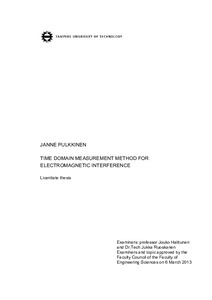Time domain measurement method for electromagnetic interference
Pulkkinen, Janne (2013)
Pulkkinen, Janne
2013
Teknisten tieteiden tiedekunta - Faculty of Engineering Sciences
This publication is copyrighted. You may download, display and print it for Your own personal use. Commercial use is prohibited.
Hyväksymispäivämäärä
2013-08-14
Julkaisun pysyvä osoite on
https://urn.fi/URN:NBN:fi:tty-201309171350
https://urn.fi/URN:NBN:fi:tty-201309171350
Tiivistelmä
The aim of this research was to study the feasibility of the time domain electromagnetic interference (TDEMI) measurement method in MIL-STD-461F compliance measurements. In the TDEMI measurement method, the measurement in time domain is performed with digital oscilloscope. After time domain measurement, comparable frequency domain amplitude spectrum is produced by Discrete Fourier Transform and by other signal processing with PC. The pros and cons of TDEMI measurement method compared to frequency domain measurement method are also evaluated in this research as well as statistical properties of TDEMI measurement results.
The research is divided in three major parts. The first part of the research is a literature review of the most essential publications related to TDEMI measurement methods and the introduction to the CE102 test method which was studied as an example. The second and the most important part of the research is the building up the TDEMI measurement system and EMI measurements with built system. Improvements for the TDEMI measurement system are also introduced in the second part. The third part is the evaluation of the built TDEMI measurement system. This is done by statistical analysis of measurement results and by comparative measurements with standard frequency domain measurement system.
The conclusion of the research is that the TDEMI measurement method is a feasible low-cost alternative for the frequency domain measurements in MIL-STD-461F CE102 measurements. In most of the practical cases the TDEMI measurement method is more time consuming than the CE102 frequency domain measurement, but if the interference signal contains infrequent phenomena, TDEMI measurement method may save time. The building up a TDEMI measurement system requires deep knowledge in measurement technology and in signal processing.
The TDEMI measurement method has also many benefits and it seems to be developable method. Possible further research areas are related to application of different window functions in the algorithm for narrowband interference and to measurements of transient interference signals with TDEMI measurement system.
The research is divided in three major parts. The first part of the research is a literature review of the most essential publications related to TDEMI measurement methods and the introduction to the CE102 test method which was studied as an example. The second and the most important part of the research is the building up the TDEMI measurement system and EMI measurements with built system. Improvements for the TDEMI measurement system are also introduced in the second part. The third part is the evaluation of the built TDEMI measurement system. This is done by statistical analysis of measurement results and by comparative measurements with standard frequency domain measurement system.
The conclusion of the research is that the TDEMI measurement method is a feasible low-cost alternative for the frequency domain measurements in MIL-STD-461F CE102 measurements. In most of the practical cases the TDEMI measurement method is more time consuming than the CE102 frequency domain measurement, but if the interference signal contains infrequent phenomena, TDEMI measurement method may save time. The building up a TDEMI measurement system requires deep knowledge in measurement technology and in signal processing.
The TDEMI measurement method has also many benefits and it seems to be developable method. Possible further research areas are related to application of different window functions in the algorithm for narrowband interference and to measurements of transient interference signals with TDEMI measurement system.
